vol. 23, No. 4, 2012, p. 581-791
2011: Before and Afterwards
During the first months of the current administration of the Brazilian Chemical Society (BSC), a strategic planning was developed, involving the Board of Directors and the Advisory Board. The Society's mission, vision, principles, external environment (opportunities and threats), internal environment (strong and weak points were all raised and discussed.
(Read more at Editorial)
Selective and Efficient Mitochondria Staining with Designed 2,1,3-Benzothiadiazole Derivatives as Live Cell Fluorescence Imaging Probes
Brenno A. D. Neto; José R. Corrêa; Pedro H. P. R. Carvalho; Diego C. B. D. Santos; Bruna C. Guido; Claudia C. Gatto; Heibbe C. B. de Oliveira; Maíra Fasciotti; Marcos N. Eberlin; Eufrânio N. da Silva Jr.
How to cite this article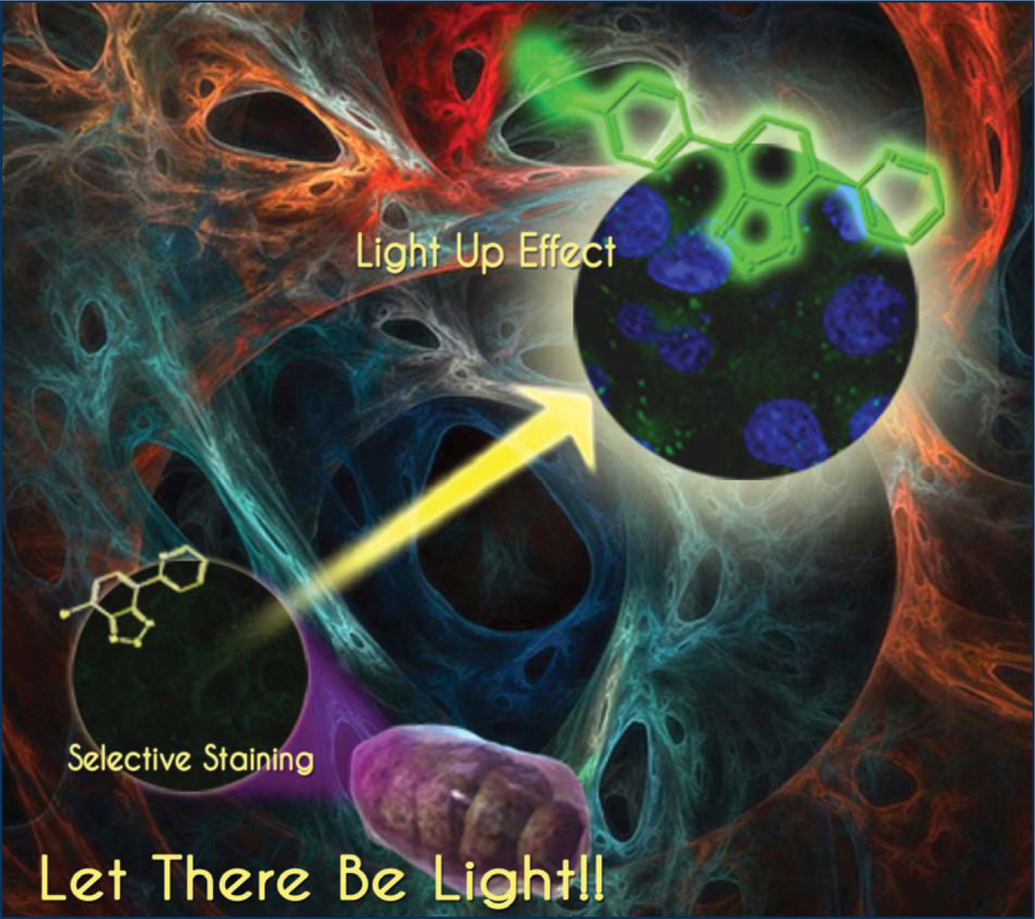
A novel fluorescent and selective probe was synthesized and used to follow a cellular process (cell division) in human breast cancer cells (MCF-7) in which the mitochondrial behavior and its distribution could be observed. Details are discussed in the Article Selective and Efficient Mitochondrial Staining with Designed 2,1,3-Benzothiadiazole Derivatives as Live Cell Fluorescence Imaging Probes by Neto et al. on page 770.
https://dx.doi.org/10.1590/S0103-50532012000400024
Editorial J. Braz. Chem. Soc. 2012, 23(4), 581-584
Articles J. Braz. Chem. Soc. 2012, 23(4), 585-592
Use of Lipase Immobilized on Celluse Support for Cleaning Aged Oil Layers
A. M. Girelli; L. Salvagni; A. M. Tarola
How to cite this article
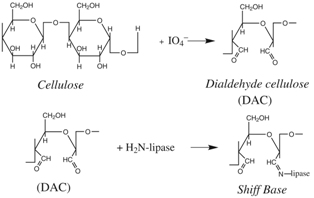
Scheme of Candida rugosa lipase immobilization on cellulose supports, like make-up remover pads, using sodium periodate as activating agent. The biocatalyst was used for the removal of the stratified aged linseed oil from canvas surfaces
https://dx.doi.org/10.1590/S0103-50532012000400002
J. Braz. Chem. Soc. 2012, 23(4), 593-601
Electrocatalytic Oxidation of Dopamine, Ascorbic Acid and Uric Acid at Poly-2,6-Diaminopyridine on the Surface of Carbon Nanotubes/GC Electrodes
Mohammad Ali Kamyabi; Mohammad Ali Shafiee
How to cite this article

Poly(2,6-diaminopyridine) on the surface of carbon nanotubes/GC electrode shows excellent electrocatalytic activity towards the oxidation of ascorbic acid, dopamine and uric acid. The graphical abstract shows the cyclic voltammograms of 2,6-DAP electro-polymerization over the range of -0.3 to 1.2 V at 50 mV s-1 for 20 cycles
https://dx.doi.org/10.1590/S0103-50532012000400003
J. Braz. Chem. Soc. 2012, 23(4), 602-609
Determination of Biphenyl and Biphenyl Oxide in Aqueous Samples by Headspace Single Drop Microextraction Coupled to Gas Chromatography
Maryam Sarkhosh; Ali Mehdinia; Ali Jabbari; Yadollah Yamini
How to cite this article
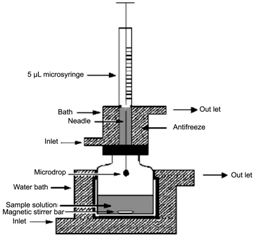
A headspace single drop microextraction (HS-SDME) coupled to gas chromatography flame ionization detection (GC-FLD) method was used for the determination of biphenyl and biphenyl oxide
https://dx.doi.org/10.1590/S0103-50532012000400004
J. Braz. Chem. Soc. 2012, 23(4), 610-617
Characterization of Pyroligneous Acid used in Agriculture by Gas Chromatography-Mass Spectrometry
João Batista G. Souza; Nilva Ré-Poppi; Jorge Luiz Raposo Jr.
How to cite this article
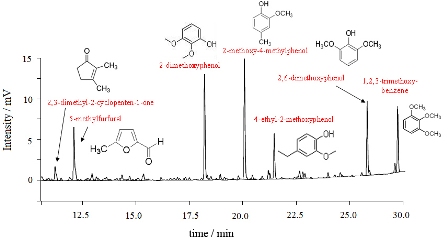
It is reported the study of a liquid sample from the pyrolysis of wood. The analysis was performed by gas chromatographs with flame ionization detector (GC-FID) and mass spectroscopy (GC-MS). The chromatographic profile corresponds to a sample of a commercial fertilizer. Syringol, 1,2,3-trimethoxybenzene, metoxy-2-4-methylphenol and o-guaiacol were the most abundant substances in the product
https://dx.doi.org/10.1590/S0103-50532012000400005
J. Braz. Chem. Soc. 2012, 23(4), 618-627
Antioxidant Activity and Phenolic Composition of Brazilian Honeys and their Extracts
Regina L. P. Lianda; Luiza D'Oliveira Sant'Ana; Aurea Echevarria; Rosane N. Castro
How to cite this article
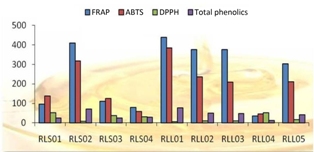
Evaluation of the polyphenolic content and antioxidant activity of orange and multifloral honey extracts was carried out by different assays. Orange honey extracts showed higher antioxidant activities and phenolic contents than multifloral honey extracts
https://dx.doi.org/10.1590/S0103-50532012000400006
J. Braz. Chem. Soc. 2012, 23(4), 628-638
Trace Metals in the Urban Aerosols of Rio de Janeiro City
Josiane Loyola; Graciela Arbilla; Simone L. Quiterio; Viviane Escaleira; Alan S. Minho
How to cite this article
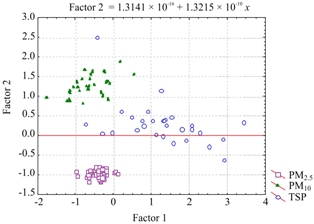
Principal component analysis was completed to examine the metal concentrations in total suspended particle (TSP) and PM10 and PM2.5 particulate matter samples, which were collected at an urban location that was strongly influenced by vehicular traffic. Our results reflect the various sources contributing to the composition of particulate matter
https://dx.doi.org/10.1590/S0103-50532012000400007
J. Braz. Chem. Soc. 2012, 23(4), 639-647
Asphalt Binders Modified by SBS and SBS/Nanoclays: Effect on Rheological Properties
Thaís F. Pamplona; Bruno de C. Amoni; Ana Ellen V. de Alencar; Ana Paula D. Lima; Nágila M. P. S. Ricardo; Jorge B. Soares; Sandra de A. Soares
How to cite this article
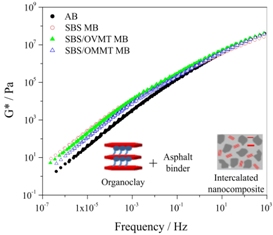
The complex modulus (G*) as a function of frequency for SBS (styrene-butadiene-styrene) modified binder (MB) and SBS/organoclays MB (as intercalated nanocomposite) showed higher values of G* when compared to the pure binder at higher temperature-low frequency. Consequently, MBs seems to be more resistant to rutting or permanent deformation
https://dx.doi.org/10.1590/S0103-50532012000400008
J. Braz. Chem. Soc. 2012, 23(4), 648-655
Ab Initio, DFT and Semi-Empirical Studies on Interactions of Phosphoryl Carbonyl, Imino and Thiocarbonyl Ligands with the Li+ Cation: Affinity and Associated Parameters
Leonardo M. da Costa; Lílian W. C. Paes; José Walkimar de M. Carneiro
How to cite this article

The electrostatic component of the Li+-L interaction (L = phosphoryl, carbonyl, imino or thiocarbonyl ligand) determines the intensity of the metal-ligand interaction enthalpy
https://dx.doi.org/10.1590/S0103-50532012000400009
J. Braz. Chem. Soc. 2012, 23(4), 656-660
Bioactive Phenylpropanoids from Daphne feddei
Yanling Lu; Xuesen Li; Huaixue Mu; Haitao Huang; Gan-Peng Li; Qiufen Hu
How to cite this article

Three new phenylpropanoids, feddeiketones A-C, were isolated from the leaves and stems of Daphne feddei, and have modest cytotoxic and anti-HIV-1 activities
https://dx.doi.org/10.1590/S0103-50532012000400010
J. Braz. Chem. Soc. 2012, 23(4), 661-669
Matrix Effect in Pesticide Analysis by Ultra Fast Liquid Chromatography Coupled to Mass Spectrometry
Diego A. Ahumada; Adriana M. Zamudio; Julio C. España
How to cite this article
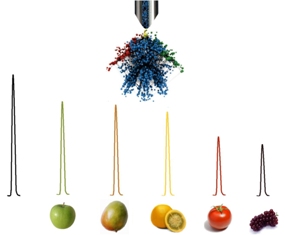
The matrix effect in residue analyses is one of the main problems at the time of the identification and quantification because it affects by far the reproducibility and accuracy of the method. This paper describes the influence of different matrices, clean-up sorbents, extraction solvents and the analyte/matrix ratio on the ionization process at UFLC-MS
https://dx.doi.org/10.1590/S0103-50532012000400011
J. Braz. Chem. Soc. 2012, 23(4), 670-677
Caffeine Determination at a Carbon Fiber Ultramicroelectrodes by Fast-Scan Cyclic Voltammetry
Ronaldo S. Nunes; Éder T. G. Cavalheiro
How to cite this article
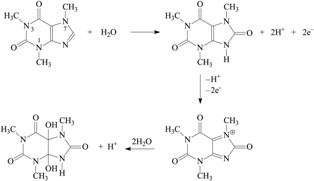
Caffeine presents a single oxidation peak at approximately +1.5 V (vs. SCE), due to an oxidation mechanism similar to xanthine, however without formation of uric acid since the nitrogen atoms at positions 3 and 7 are substituted. The oxidation occurs via a 4 electrons process resulting in a substituted uric acid (IV) that is electro-inactive
https://dx.doi.org/10.1590/S0103-50532012000400012
J. Braz. Chem. Soc. 2012, 23(4), 678-687
Volatile Characterization by Multivariate Optimization of Headspace-Solid Phase Microextraction and Sensorial Evaluation of Chardonnay Base Wines
Juliane E. Welke; Mauro Zanus; Marcelo Lazzarotto; Karine G. Schmitt; Claudia A. Zini
How to cite this article
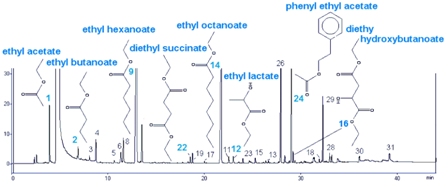
Esters, as the major and higher impact odor compounds of a typical base wine from Serra Gaúcha in a total ion current chromatogram, obtained through headspace solid phase microextraction and gas chromatography with mass spectrometric detector
https://dx.doi.org/10.1590/S0103-50532012000400013
J. Braz. Chem. Soc. 2012, 23(4), 688-693
An Efficient Methodology for the Synthesis of 3-Styryl Coumarins
Sérgio M. A. Martins; Paula C. S. Branco; António M. D. R. L. Pereira
How to cite this article
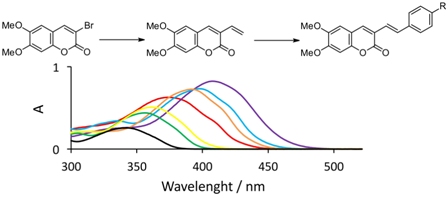
A particularly useful and concise synthesis of 3-styryl coumarins in good to high yields using Heck coupling reactions between 3-vinyl-6,7-dimethoxycoumarin and aryl halides
https://dx.doi.org/10.1590/S0103-50532012000400014
J. Braz. Chem. Soc. 2012, 23(4), 694-701
Ultrasound-Assisted Surfactant-Enhanced Emulsification Microextraction Combined with HPLC for the Determination of Estrogens in Water
Yan Zou; Yanhua Li; Hua Jin; Deqing Zou; Mousheng Liu; Yaling Yang
How to cite this article
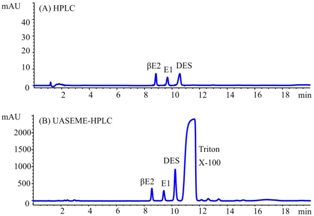
A method based on ultrasound-assisted surfactant-enhanced emulsification microextraction (UASEME) was proposed to determine estrogens in water. Significant enrichment factors were found, 85.29 for 17ß-estradiol (ßE2), 173.45 for estrone (E1) and 97.05 for diethylstilbestrol (DES)
https://dx.doi.org/10.1590/S0103-50532012000400015
J. Braz. Chem. Soc. 2012, 23(4), 702-709
Effect of Tungsten Doping on Catalytic Properties of Niobium Oxide
Franciane P. Cardoso; Andre E. Nogueira; Patrícia S. O. Patrício; Luiz C. A. Oliveira
How to cite this article
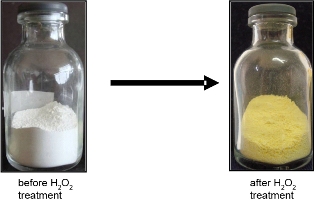
The treatment of Nb5+ soluble salts with H2O2 makes the solution yellowish due to the formation of peroxo-niobium groups. The color change was also observed with solid material
https://dx.doi.org/10.1590/S0103-50532012000400016
J. Braz. Chem. Soc. 2012, 23(4), 710-717
Fast and Interference Free Determination of Calcium and Magnesium in Honeys by Solid Phase Extraction Followed by Flame Atomic Absorption Spectrometry
Pawel Pohl; Helena Stecka; Piotr Jamroz
How to cite this article
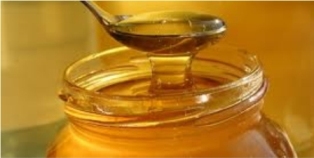
A fast and interference free FAAS method for the determination of Ca and Mg in honeys using the solid phase extraction and the two-step elution was developed. It maintained the precision of 1-5% and the accuracy of 1-3%. The limits of detection of 24 ng g-1 of Ca and 4.4 ng g-1 of Mg were obtained
https://dx.doi.org/10.1590/S0103-50532012000400017
J. Braz. Chem. Soc. 2012, 23(4), 718-726
Influence of the Rainfall Regime on the Mobility of Zn, Cd, Ni, Cu, Mn and Fe in the Surface Sediments of the Contas River Located in the Brazilian Semi-Arid Region
José S. dos Santos; Marcio J. S. dos Santos; Maria L. P. dos Santos
How to cite this article
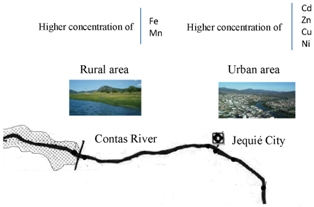
Zn, Cu, Cd and Ni exhibit higher concentrations in the sediments within the city. The elements Mn and Fe showed higher concentrations in sediments collected outside the urban area and this result may be attributed to contributions from agricultural activities
https://dx.doi.org/10.1590/S0103-50532012000400018
J. Braz. Chem. Soc. 2012, 23(4), 727-736
A Comprehensive Investigation of the Mineral Composition of Brazilian Bee Pollen: Geographic and Seasonal Variations and Contribution to Human Diet
Marcelo A. Morgano; Márcia C. Teixeira Martins; Luana C. Rabonato; Raquel F. Milani; Katumi Yotsuyanagi; Delia B. Rodriguez-Amaya
How to cite this article

Emission spectrometry (ICP OES) was used to determine the mineral composition of bee pollen from different Brazilian regions. Brazilian bee pollen may be considered a rich source of Mn and Se and a source of Cu, P and Zn. The elements Ca, Cu, Fe, K, Mg, Mn, Na, P and Zn were important in explaining the classification of pollen according to their geographical origin. The mineral levels varied widely during the year
https://dx.doi.org/10.1590/S0103-50532012000400019
J. Braz. Chem. Soc. 2012, 23(4), 737-746
Influence of Spatial, Edaphic and Genetic Factors on Phenols and Essential Oils of Myrciaria cauliflora Fruits
Alessandra R. Duarte; Suzana C. Santos; José C. Seraphin; Pedro H. Ferri
How to cite this article

Venn diagrams illustrating the amount of variation in M. cauliflora fruit chemical composition explained by edaphic and spatial predictor variables and joint effects
https://dx.doi.org/10.1590/S0103-50532012000400020
J. Braz. Chem. Soc. 2012, 23(4), 747-752
Nanostructure of Polystyrene-b-poly(2-Hydroxyethyl Methacrylate) and Derivatives with Phosphonic Diacid Groups
Vanessa Schmidt; Redouane Borsali; Cristiano Giacomelli
How to cite this article

Selective interactions between proteins and nanomaterials are of interest for the fabrication of biochips with applications spanning from diagnostics to electronics. This study reports the preparation of block copolymer nanodomains featuring phosphonic diacid groups, which were previously shown to reversibly bind to Annexin-A5 proteins
https://dx.doi.org/10.1590/S0103-50532012000400021
J. Braz. Chem. Soc. 2012, 23(4), 753-762
Evaluation of Signal-to-Background and Mg II/Mg I Ratios as Response for the Optimization of Rare Earth Elements Determination by Inductively Coupled Plasma Optical Emission Spectrometry
Aline K. Guimarães-Silva; Jorge C. de Lena; Roberta E. S. Froes; Letícia M. Costa; Clésia C. Nascentes
How to cite this article
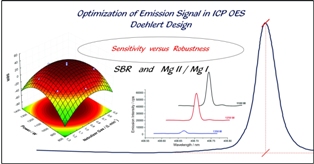
The operating conditions of an inductively coupled plasma optical emission spectrometer were optimized for the determination of REEs using a Doehlert design and the signal-to-background ratio (SBR) of the REEs emission signals and the Mg II/Mg I line intensity ratio were evaluated as response functions
https://dx.doi.org/10.1590/S0103-50532012000400022
J. Braz. Chem. Soc. 2012, 23(4), 763-769
Chromatographic Analyses of Fatty Acid Methyl Esters by HPLC-UV and GC-FID
Myller S. Carvalho; Márcio A. Mendonça; David M. M. Pinho; Inês S. Resck; Paulo A. Z. Suarez
How to cite this article
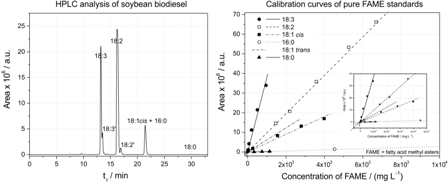
Two high-performance liquid chromatographic (HPLC) methods with ultraviolet detection are described: one for simultaneous determination of total amounts of triacylglycerides, diacylglycerides, monoacylglycerides and fatty acid methyl esters (FAME) in alcoholysis of different oils, and the other one suitable for determining the fatty acid composition of oils analyzing their methyl ester derivatives
https://dx.doi.org/10.1590/S0103-50532012000400023
J. Braz. Chem. Soc. 2012, 23(4), 770-781
Selective and Efficient Mitochondria Staining with Designed 2,1,3-Benzothiadiazole Derivatives as Live Cell Fluorescence Imaging Probes
Brenno A. D. Neto; José R. Corrêa; Pedro H. P. R. Carvalho; Diego C. B. D. Santos; Bruna C. Guido; Claudia C. Gatto; Heibbe C. B. de Oliveira; Maíra Fasciotti; Marcos N. Eberlin; Eufrânio N. da Silva Jr.
How to cite this article
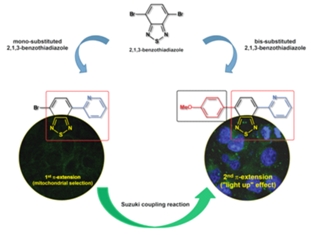
Novel designed 2,1,3-benzothiadiazole (BTDs) derivatives were synthesized and tested as selective fluorescent cell markers. The first pi-extension was responsible for the cellular selection (mitochondrial selection) while the second pi-extension resulted in a pronounced "light up" effect. The rationally designed derivative (BTDShiny) was tested to monitor a key cellular process (cell division cycle) using MCF-7 cancer cell lines (human mammal cells), thus allowing future studies of cancer cell death and their processes that are highly associated with mitochondrial stability
https://dx.doi.org/10.1590/S0103-50532012000400024
Short Reports J. Braz. Chem. Soc. 2012, 23(4), 782-785
Meroterpenes from Peperomia oreophila Hensch. and Peperomia arifolia Miq.
Karina J. M. Salazar; João Henrique G. Lago; Elsie F. Guimarães; Massuo J. Kato
How to cite this article
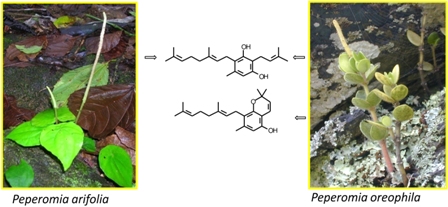
The major meroterpenes isolated from Peperomia oreophila Hesch. and Peperomia arifolia Miq. have in common the aromatic moiety derived from orsellinic acid
https://dx.doi.org/10.1590/S0103-50532012000400025
J. Braz. Chem. Soc. 2012, 23(4), 786-791
Strategies to Improve Accuracy and Sensitivity in Phosphorus Determinations by Inductively Coupled Plasma Quadrupole Mass Spectrometry
George L. Donati; Renata S. Amais; Joaquim A. Nóbrega
How to cite this article
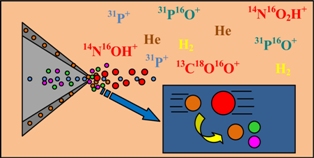
The collision/reaction interface (CRI) with He introduced through the skimmer at 100 mL min-1 is employed to improve ICP-QMS accuracy in 31P+ determinations. Cool plasma conditions for the determination of 31P16O+ result in limits of detection 55-fold lower. This strategy is an interesting alternative for high ionization potential elements such as P
https://dx.doi.org/10.1590/S0103-50532012000400026
Online version ISSN 1678-4790 Printed version ISSN 0103-5053
Journal of the Brazilian Chemical Society
JBCS Editorial and Publishing Office
University of Campinas - UNICAMP
13083-970 Campinas-SP, Brazil
Free access










